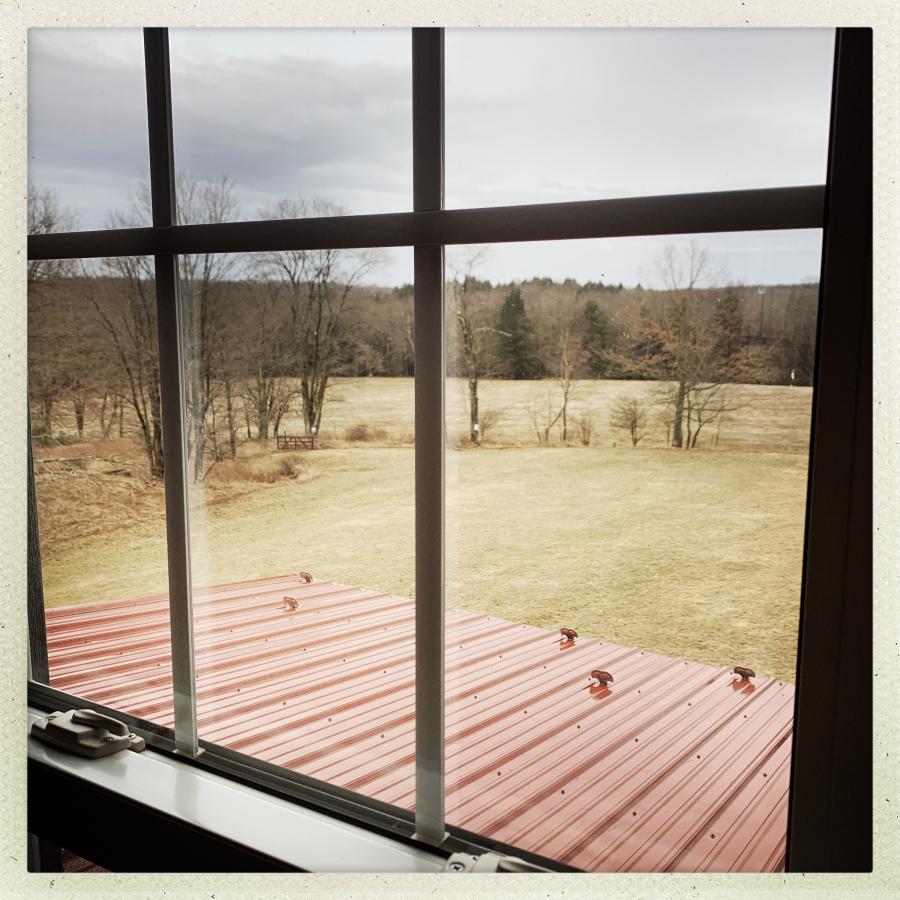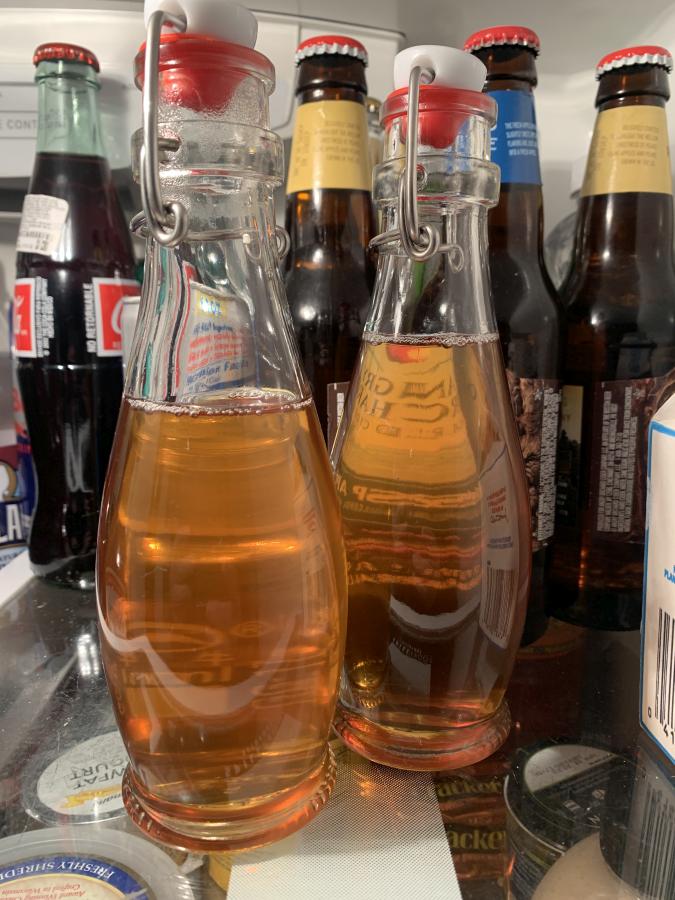From my bedroom window, this is one of the views:

Look at the bottom of the trees, you can see the buckets (there are 2 more out of sight). I have a pretty good scope on my .22 rifle, and I can measure how much sap is in any one of the buckets by reading the graduation-lines on the outside while I’m still in my bathrobe.
A bucket of 5 gal of sap is pretty heavy and my grass is slippery and has a lot of deer poo. I’m not enjoying hauling around buckets of sticky juice so much, I have to admit.
I still don’t know if I’m going to bother doing this next year, because boiling down is a pain in the ass. But this year, when the leaves are out on the trees, I’m going to mark 6 maple trees along my driveway. See, the driveway goes through about 1/4 mile of woods (aka: “my woods”) and it’s a mixture of oak, maple, and pine. Instead of hauling along buckets, I’ll just do a slow drive-through in the tahoe and aggregate the sap into a big container in the back. I’ll have to be careful of the ditches on the side of the driveway – they’ll eat a car pretty easily.
A couple of other random maple-related things: a lot of syrupers age the stuff in oak barrels, which brings up the question of char and watering the barrel. It sounds like a fun thing. Originally I wrote that idea out of consideration because I have childhood experience with wine barrels and I think of “barrel” as a mighty heavy force of nature. But it turns out there are places that sell practical small barrels: 1 and 2 liter models are available. [barrels online] Barrel-making is a project that is too demanding and over the top for me, but barrel-buying is something I’ll be considering for next year’s harvest.

That’s a pretty good haul for a day, really! I’m going to take one of those to my parents, as a “thank you” for the many years of pancakes.

I know how you feel. I know a few syrupers and have helped them out in the past. It is a lot of work. Too much work for me. Those that have scaled up have a lot of money invested and a lot of time. I am not willing to put that much effort into it when I can buy local WI maple syrup at any specialty shop or at our local meadery/distillery.
What do those ornaments on the roof do?
Do you really need a barrel? Or can you put a few pieces of charred oak, or whatever, in your glass bottle, and age it that way? My “estimate” (read: guess) is that you need one or two splinters the size of a pencil per liter to get the same ratio of syrup volume to wood surface area as in a large barrel.
I can’t help it. I see a sugary syrup and go straight to “add water, yeast, yeast nutrient; ferment; distill”.
I’ve seen maple syrup sold that was aged in bourbon barrels.
One interesting tidbit I’ve heard about barrels from my brother-in-law (who runs a craft distillery) is that it used to be that traditionally bourbon-makers would buy barrels (bourbon is supposed to be aged in new, charred barrels) and then whiskey producers would buy the barrels from them (whiskey is usually ‘finished’ in barrels that have already been used for something else to pick up the flavours). But these days often rather than deal with that, the whiskey makers often are the ones buying the casks, which they rent out to other distillers or wineries to start with before taking them back. In either case, there’s a massive amount of trans-Atlantic trade in aging barrels going between American bourbon distilleries and Irish whiskey distilleries.
@2 Those are snow guards. When you have a smooth roof (e.g. metal or slate) you want to prevent a large quantity of snow and/or ice from slipping down and dumping over the edge of the roof, particularly where people might be.
What do those ornaments on the roof do?
They’re life-savers. When the ice on the roof loosens it can drop a ton of ice two stories onto your head. Not a preferred death.
Rob Grigjanis:
I can’t help it. I see a sugary syrup and go straight to “add water, yeast, yeast nutrient; ferment; distill”
Dendarii maple bourbon!
I think that it’s probably way too high-cost for a base for fermentation. Yeast would not be impressed with the high class environment. On the other hand, maple syrup barrels would be interesting for ageing rye sugar alcohol distillate.
I have a friend who made a barrel he called “double felony” moonshine with a whole lot of marijuana bud in it. It was horrible. I tried a little bit and it was like mouthwash that leaves you drooling on the couch.
jenorafeuer@#5:
In either case, there’s a massive amount of trans-Atlantic trade in aging barrels going between American bourbon distilleries and Irish whiskey distilleries.
That’s a transatlantic trade I can get behind.
The barrel company I referenced produces already charred barrels. I guess that’s the head of the river of use and re-use.
I’m not sure what I think about using ageing to flavor. The stuff is delicious enough as it is. Although I read about one guy who also makes his own bourbon vanilla (!!) and cycles his barrels back and forth. Brilliant!
cvoinescu@#3:
I also thought of that. It seems an obvious idea. A bit of charred oak would go a long way. I’m worried it might be going too far.
In 1998 I visited the Laphroiag distillery on Islay (unannounced Americans appearing out of nowhere) and I got to experience the scent of peat-fired distilling. It’s an amazingly enduring scent. I’m sure some of the blog’s readers love it but it’s not for me. I run toward Solera or port.
“I’m sure some of the blog’s readers love it”
Lagavulin is the closest thing I’ve ever tasted to perfection. Ymmv.
I don’t think it’s lazy to use machinery to collect heavy items like full 5 gallon buckets, rather than risking your back. I am wondering how you would move and empty a container that contained all six buckets worth of sap? Wouldn’t it be easier to simply swap the filled buckets with empties. Just one weighs about 45 pounds, which may be nothing to you, but is not exactly lightweight IMO.
Some Old Programmer @ # 6 & Marcus Ranum @ # 7 – Thanks for the explanations – us Southronners have no clue about such things.
Most of our roofs would cave in long before such a load became a real threat to anyone walking outside.
It’s been a while since I’ve lived somewhere with snow, but I vaguely remember some claim that those… projections? were less to prevent snow sliding off the roof, than it was to prevent the snow from sliding into and damming the gutters, which would then lead to water pooling on the shingles and getting under them and damaging the interior structure.
Although, that would be less of a concern on a metal roof…
If one were trying to ferment the syrup/sap, I imagine a lot of effort could be saved by bringing it to a boil for sanitizing purposes, and then just reducing until the desired sugar content, which would probably be far more diluted than the eventual syrup.
I mentioned on the previous thread that I thought something about tree saps had come up before, and I think it may have been this post:
https://freethoughtblogs.com/stderr/2019/10/22/fall-colors-2019-7/
may have been others, I’m too tired to do a very thorough check, and my search skills are rather lacking… (along with my memory…)
@lochaber: thanks for that link. The two trees with the most leaves are my biggest sap producers and the one in front is giving almost nothing because it may be dead.
Back in the day, when a barn was built, they would sometimes plant trees like these on the ramp. I suspect it was sentimentality and perhaps a good anchor-post for blocking and tackling something heavy. That’s the old barn ramp (I pulled the barn down with the tractor in 2005) and those trees are probably pretty old. 1890s or so.
Tethys@#12:
I am wondering how you would move and empty a container that contained all six buckets worth of sap?
Due to the desire to keep the buckets from getting infected, my plan was to make a grid-box out of 2x4s that would keep the buckets upright and then swap the buckets. Buckets are cheap.
Have you considered using sap lines?
https://leaderevaporator.com/in-the-sugarbush/tubing-systems/
That’s what most producers of Maple syrup use here in the (USA) land of Maple syrup (Vermont).
Saves a bunch on the effort for sure.
My kids actually learned to tap a tree and make syrup the old fashioned way when they were in elementary school. Part of the curriculum here in some schools…
Patrick Slattery@#17:
Have you considered using sap lines?
Yes. That’s a “full production” thing. You still have to take them down and clean them, etc. Also you may catch at ATVer or attract a bear. I like bears, though.
The main thing is that if I put up lines, I just wind up with one really big really heavy bucket that I still have to move the contents of.
For now my small-time efforts remain satisfying.
Thanks for the clarification @16 Marcus.
I wonder if paint suppliers already make such racks for five gallon buckets? A small box trailer would be very handy too. You could collect your sap, and back it right into the processing area.
Marcus Ranum @10
I’m sure some of the blog’s readers love it
That would include me, though I don’t drink Laphroiag or anything much these days what with the opioid painkillers and the paracetamol (acetamorphin) painkiller consumption.
Hauling around… can you perhaps lease a small tracked vehicle for a day? It would be expensive but might provide experience for wether the idea is feasible.
birgerjohansson@#21:
Hauling around… can you perhaps lease a small tracked vehicle for a day?
The sap run appears to be a couple of weeks long. Since I already have a great big SUV (that is pretty ratty inside) I have hauling covered. It’s a complete system scaling problem. If I double my sap collection I need to double my hauling and boiling capacity, which means more infrastructure cost (a boiler shed and a woodpile and a bottling setup and and and…)